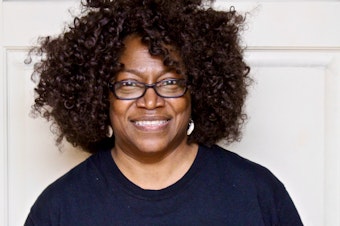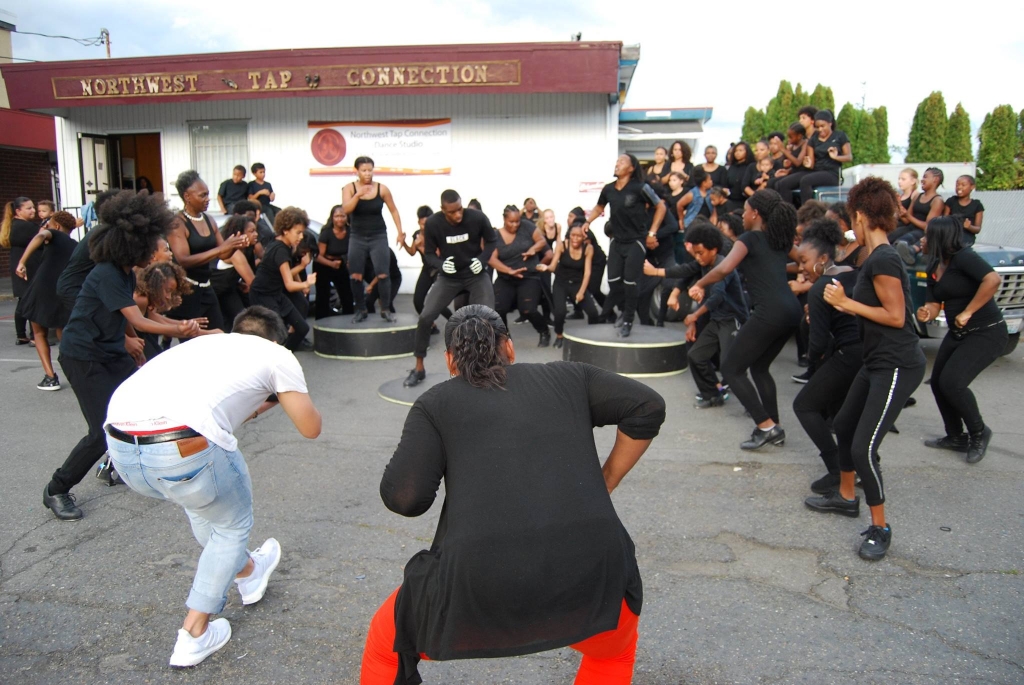
Created by: Serena , Ale, Alysa, and Diego
What is the Tacoma Urban Performing Arts Center? The Tacoma Urban Performing Arts Center (T.U.P.A.C.) is a studio located in Downtown Tacoma, providing classical training in the area. The studio was established July 8, 2017 with founders Kabby Mitchell III and Klair Ethridge, giving marginalized communities of children an opportunity to obtain quality dance instruction from local faculty members. The center holds classes for children and adults alike, ranging from a variety of styles including but not limited to: West African, Ballet and Pointe, as well as Hip-Hip and Urban Contemporary styles.Founder: Kabby Mitchell III In 1979, Kabby Mitchell III became the first African American member of Pacific Northwest Ballet, a ballet company in Seattle. He ranked soloist and left P.N.B. in 1984; he continued to perform with multiple other dance companies internationally. Mitchell grew up in the San Francisco Bay Area and studied dance at California’s Contra Costa College. He later earned his MFA in dance from the University of Iowa in 1998. Mitchell began teaching “Dancing Molecules, Dancing Bodies” at The Evergreen State College as a Dance and African American Studies faculty member that same year. Before he passed away in 2017, he started the Tacoma Urban Performing Arts Center (T.U.P.A.C.). His legacy as a dancer and proud gay man survives in the Seattle arts community.

Mission Above all, T.U.P.A.C. focuses on its students. Its mission is to give “deserving youth opportunities to achieve artistic excellence” through “community classes and pre-professional classical ballet training… national and international mentors and intergenerational guest artists… [and] whole person development and community give back” (T.U.P.A.C. website). They seek to “bring classical ballet to an urban community, especially students of color, where they have role models and instructors who look like them and inspire them” (Hemmann, 2019). Through scholarships and free classes, the center makes dance cost-accessible to an urban community, letting students participate in dance who would have otherwise been unable to afford lessons. T.U.P.A.C. brings students together in a close-knit family, where students support each other and teachers serve as role models. Participating in dance not only gives students a chance to develop their skills on a technical level — agility, flexibility, physical stamina — but also on a personal development level. Students learn cooperation, diligence, discipline, and self-confidence. Parents see their children develop both in dance and character. Especially “in families where an activity like dance has never been a part of life, it often has a positive ripple effect for everyone” (Hemmann, 2019).
Achievements T.U.P.A.C. has only been open for a few years, but their achievements are already admirable. In 2018, they did their debut of “The Urban Nutcracker,” performing a story set in Tacoma which brought together students of all ages in an amazing performance. It was “an energy-packed show” with a mix of ballet, hip-hop, and African dance (Hemmann, 2019). They also perform dance in the community at places like the Annie Wright School, NAACP, and the Tacoma Art Museum.

Membership T.U.P.A.C. works with excellent teachers and performers to bring high-quality dance to students. Klair Ethridge is the co-founder and director of T.U.P.A.C.. She finds high-profile guest teachers and supports students both in and out of classes, even giving them rides home if needed. In her words, she has found that “to help… students realize that in dance class they must keep pushing their boundaries and reassessing themselves by setting new goals.” She believes that “Kabby’s dream has become a reality” and says: “This is always what he wanted; a ballet school where children can practice dance whether their parents are financially able or not, whether they have a ‘classic’ ballet body, or not – whether or not their hair is in a bun.” (Klair Ethridge, qtd. in T.U.P.A.C.: The Inaugural Year) Jade Solomon Curtis is a master teacher at T.U.P.A.C., a choreographer and dance artist. With the motto “activism is the muse,” she uses her dance to express and appreciate black culture. She combines contemporary dance and Hip Hop cultural influences to “ponder tradition and reinvention, social justice, [and] social constructs” through “the lens of a contemporary black woman” (Jade Solomon website). Awal Alhassan is another master teacher at T.U.P.A.C., specializing in West African dance. He was born in Tamale, Ghana and raised “by a traditional drumming and dancing family.” He has “worked throughout Africa both independently and with some of Ghana’s performance groups” (T.U.P.A.C. website).
Significance to Communities of Color As stated before, T.U.P.A.C creates an accessible means for marginalized communities to obtain dance education, specifically the black youth of the Tacoma area. The studio took into account the ways in which a child could not only experience dance in its diverse forms, but also gain an education and enrich the lives of those who join with them. To create this education, T.U.P.A.C. offers parents the opportunity to be members of the Parent Guild Association (P.G.A.) upon registration of their students. The studio uses and emphasizes this program to give parents a way to be more invested in their child’s education and training, considering it “paramount to the success of [their] school” (T.U.P.A.C. Website). Being a black-dominant space, the studio provides the ability for black students to learn and grow with other black students in the community, and allows interpersonal connections and networking to happen from the ground level with people of the same identities. Due to dance traditionally not being an art form in which black people are prominent, T.U.P.A.C. provides all of their students an opportunity to express themselves creatively in a space that was curated by and made for the black youth to partake in. The studio also makes themselves more accessible to students and families through their website, where they will give you the option to shop. This particular shop option is different than the average retail store- it allows for people within and outside of the community to donate to students in multiple ways: through donating straight to the studio, through buying products from the studio, and donating money towards clothing (leotards, ballet slippers, tights). Through this, T.U.P.A.C. allows themselves to become even more accessible to students and families who may or may not be able to afford these materials otherwise.
Significance in Ballet In particular, black people are underrepresented in the ballet community. Theresa Ruth Howard, founder and curator of the Memoirs of Blacks in Ballet, says that “ballet is a rarefied career and its icon—a ballerina—is petite, lithe, fragile, ethereal and white. Some call it tradition, others call it the classical aesthetic” (2015). In 2012, the English National Ballet only had two black dancers out of 64, and the Royal Ballet has four out of 96 (Goldhill & Marsh, 2012). Kristan Hanson, a writer for the Encyclopedia Britannica, said that in 2015, “the lack of racial diversity in Ballet was one of the dance world’s most-discussed issues” (2015). Organizations like T.U.P.A.C. give black communities a greater opportunity to participate in ballet, thereby helping to change the perception of this form of dance. T.U.P.A.C. makes ballet lessons more accessible to students of color and works to combat traditional ballet stereotypes.

Connection to Arts Education Background: Redlining and Education Redlining refers to the discriminatory real estate practice of rejecting or limiting the credit extensions and loans of specific geographic areas (Jacobs, 2018). This practice undermines property value by amplifying white flight in “hazardous” and “declining” areas that correspond to integrating neighborhoods; the loss of population starves the areas from economic growth and perpetuates the irrational fear of race as a financial risk (Badger, 2017). As a result, it often lowers resident’s property taxes, thereby making white flight self-fulfilling. The wealth accumulation of redlined households becomes restricted as loans for local businesses and other entrepreneurs are denied based on the perceived risk (Kye, 2018). The drop in the private sector’s willingness to invest encourages businesses to leave the neighborhood. This shrinks the market, cuts employment opportunities, and lowers disposable income. A lower level of income, on account of the loss of earnings, causes a drop in the local tax base as the government earns less revenue from sales and income taxes in addition to the already diminished property tax transfers. Losses in a local tax base are notable in education as an average 45 percent of public K-12 education is fed by local taxes (Turner, et al., 2016). With a lowered expenditure capacity and often without the public support for the state to close the gap, cuts in the school budgets of communities of color are common and tend to hit the arts first, fueling the narrative of part-time art teachers and their barely-breathing programs (Chang, 2018). Education Inequity in the Arts Federal programs like No Child Left Behind are supposed to “create equitable educational opportunities for all students and close achievement gaps among different groups of students, particularly minorities and whites,” but the unsolved effects and continued practice of redlining often outweigh whatever progress this bill provides (Chappell, 2013). African American children are still not able to access the same quality of education as other children, especially in the arts. Math and reading have become integral to the standardized measure of learning, while dance and music fall behind. If the arts are not included in the formal curriculum, allocation of funds diverges more significantly and turns programs from barely-breathing to nonexistent (Chang, 2018). For students in an urban community, losing an arts education creates a pipeline problem, translating later into a shortage of representation.
“Just 26 percent of African-American adults surveyed in 2008 reported having received any arts education in childhood, a huge drop from the 51 percent who replied affirmatively in 1982.” (Robelen, 2011)
Organizations like T.U.P.A.C. lessen the strength of the pipeline problem by providing affordable dance lessons for students who would otherwise have not had the opportunity to participate. It is an exemplary story of community that deserves high praise.Bibliography Badger, Emily. “How Redlining’s Racist Effects Lasted for Decades.” The New York Times, The New York Times, 24 Aug. 2017, www.nytimes.com/2017/08/24/upshot/how-redlinings-racist-effects-lasted-for-decades.html. Chang, Alvin. “We Can Draw School Zones to Make Classrooms Less Segregated. This Is How Well Your District Does.” Vox, Vox, 27 Aug. 2018, www.vox.com/2018/1/8/16822374/school-segregation-gerrymander-map. Chappell, Sharon Verner, and Melisa Cahnmann-Taylor. “No Child Left With Crayons.” Review of Research in Education, vol. 37, no. 1, 1 Mar. 2013, pp. 243–268., doi:10.3102/0091732×12461615. Goldhill, Olivia, and Sarah Marsh. “Where Are the Black Ballet Dancers?” The Guardian, Guardian News and Media, 4 Sept. 2012, www.theguardian.com/stage/2012/sep/04/black-ballet-dancers. Hanson, Kristan M. “Addressing Racial Diversity in Ballet.” Encyclopædia Britannica, Encyclopædia Britannica, Inc., 1 July 2015, www.britannica.com/topic/Addressing-Racial-Diversity-in-Ballet-2030912. Hemmann, Gale. “T.U.P.A.C.: Tacoma Urban Performing Arts Center Brings World-Class Dance to All.” South Sound Talk, 7 Jan. 2019, www.southsoundtalk.com/2019/01/03/t-u-p-a-c-tacoma-urban-performing-arts-center-brings-world-class-dance-to-all/. Howard, Theresa R. “Diversity Is the New Black.” Dance Magazine, Dance Magazine, 28 Dec. 2015, www.dancemagazine.com/diversity-is-the-new-black-2307002349.html. Jacobs, Tom. “’White Flight’ Remains a Reality.” Pacific Standard, 6 Mar. 2018, psmag.com/social-justice/white-flight-remains-a-reality. “Jade Solomon.” Jade Solomon, www.jadesolomon.com/. Kye, Samuel H. “The Persistence of White Flight in Middle-Class Suburbia.” Social Science Research, vol. 72, 2018, pp. 38–52., doi:10.1016/j.ssresearch.2018.02.005. Macdonald, Moira. “ Kabby Mitchell III, First Black Dancer with Pacific Northwest Ballet, Dies .” The Seattle Times, The Seattle Times Company, 11 May 2017, www.seattletimes.com/seattle-news/kabby-mitchell-iii-first-black-dancer-with-pacific-northwest-ballet-dies/. Sailor, Craig. “He Brought TUPAC to Tacoma’s Underserved Kids, but Famed Dancer Won’t See Final Work.” Thenewstribune, Tacoma News Tribune, 13 July 2017, www.thenewstribune.com/news/local/article161164353.html. “Tacoma Urban Performing Arts Center.” Tacoma Urban Performing Arts Center, 2017, tacomaupac.org/t-u-p-a-c. “Tacoma Urban Performing Arts Center: The Inaugural Year.” The Tacoma (WA) Chapter of The Links, July 2018, tacomalinksinc.org/wp-content/uploads/2018/07/TUPAC-Booklet-Final.pdf. Turner, Cory, et al. “Why America’s Schools Have A Money Problem.” NPR, NPR, 18 Apr. 2016, www.npr.org/2016/04/18/474256366/why-americas-schools-have-a-money-problem.






